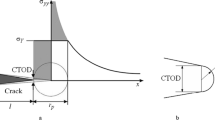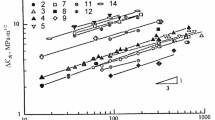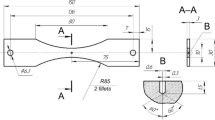The paper presents results of fatigue tests in the tension–compression and tension–tension modes of specimens of 45 steel: smooth specimens and specimens with a blind hole of different diameters of 0.6 and 1.6 mm. The fatigue resistance of specimens with a 1.6 mm hole is higher than that of specimens with a 0.6 mm hole. This is accounted for by the different mechanisms of reaching the endurance limit in both cases, which is a consequence of different gradients of local stresses in the vicinity of the hole. For the specimens with a smaller hole, the endurance limit is determined by the nominal stress for the initiation of a crack of the size not exceeding the grain size, as this is the case in smooth specimens too. For the specimens with a larger hole, the endurance limit is determined by the threshold nominal stress required for the propagation of a crack whose size is larger than the grain size. To theoretically estimate the endurance limit in the presence of a stress raiser in the form of a hole, the critical distance concept as a single parameter for a particular material can be successfully used, but if the radius of the hole does not exceed a certain critical value. A formula for the estimation of this value as a function of the material characteristic and theoretical stress concentration factor is proposed. The same formula can be used to determine the critical value of the theoretical stress concentration factor, above which the endurance limit in the presence of a stress raiser of the same depth and different sharpness remains unchanged.
Similar content being viewed by others
Avoid common mistakes on your manuscript.
Introduction. The endurance limit of specimens and structural elements in the presence of a stress raiser is analyzed using different approaches depending on the stress raiser geometry [1, 2]. To estimate the endurance limit of specimens with “blunt” and “shallow” stress raisers (the theoretical stress concentration factor Kt ≤ 4), the critical distance concept is used [1]. The endurance limit in the presence of a blunt stress raiser is determined by the nominal stress at which the local stress at the critical distance from its tip is equal to the endurance limit of smooth specimens. The critical distance characterizes the depth of the surface layer with mechanical properties differing from those of the bulk material, in which during cyclic loading, local plastic strains occur and then cracks nucleate [3]. The thickness of this layer can reach the size of one grain for coarse-grained materials to several tens of grains for fine-grained materials. Its absolute value can be an order of magnitude smaller for fine-grained materials [2].
When using the critical distance concept, it is assumed that at the endurance limit of specimens with a blunt stress raiser, no crack occurs, or if it is formed from the stress raiser tip and does not propagate further, its size does not exceed the grain size d, as is the case for smooth specimens [1, 4].
The data, known from publications, as to the size of the crack existing at the endurance limit of specimens with blunt stress raisers (in particular, holes) are very contradictory [5]. They generally report the presence of such a crack, but irrelative of the grain size. Its size increases with the stress raiser depth [6].
For other (“sharp” and “deep”, Kt > 4) types of stress raisers, the endurance limit can be determined by the threshold applied stress range at which a fatigue crack is initiated at the stress raiser tip, which grows to a certain size (which is larger than the grain size) and stops propagating because of the gradually increasing crack closure effect. In such cases, approaches using a modified Kitagawa–Takahashi diagram (KT-diagram) are proposed to analyze the endurance limit [2].
Besides the above limitation of the use of the critical distance concept for a particular type of stress raisers (only for blunt ones), there can also be a limitation in terms of their size. The aim of this research was to determine this limitation by analyzing fatigue test results for steel specimens with blind hole of different diameters.
Experimental Results. The high-cycle fatigue tests were carried out on a RUMUL Testronic 50kN resonant testing machine in the tension–compression (R = −1) and tension–tension (R = 0.1) modes under normal conditions, where R is the ratio of the minimum cycle stress σmin to the maximum one σmax. Flat specimens of 45 steel: smooth specimens and specimens with a blind hole of diameter 2ρ = 0.6 and 1.6 mm were tested (Fig. 1). The nominal stresses σnom in the net section of the specimen were calculated as
where P is the loading force according to the readings of the load sensor of the testing machine, a and t are the dimensions of the smallest rectangular cross-section of the specimen, and δ is the cross-sectional area of the stress raiser.
Fatigue test results for 45 steel specimens are given in Fig. 2 in the applied maximum nominal cycle stress σmax – cycles to failure (N) coordinates.
Results of Fractographic Investigations and Calculation of the Stress-Strain State (SSS) in the Stress Raiser Vicinity. The fatigue fractures of specimens with a stress raiser were investigated with the aid of a VEGA 3 TESCAN scanning electron microscope (SEM). As a result, it has been found that fatigue crack initiation occurred from the surface of the stress raiser, i.e., the blind hole, at several sites. As a rule, one or two of them are at a depth at about 0.3–0.5 mm from the specimen surface (Fig. 3). This fact is in good agreement with the results of an elastic finite-element analysis of the SSS in the vicinity of this hole (Fig. 4), which indicate the presence of a maximum of local stresses on the hole surface at a depth of 0.3 mm from the specimen surface. As is seen from Fig. 4, the local stress at the depth of 0.3 mm is ~ 12% higher than on the surface.
Since the difference of 12% is small, fatigue crack initiation can occur on the specimen surface too, i.e., from the vertex of the angle between the specimen surface and the hole surface (Fig. 5).
Thus, the front of an initially short crack can be either semi-elliptical, if this crack was initiated at a depth under the specimen surface, or quarter-elliptical, if it was initiated from the angle on the specimen surface. In both cases, when watching on the specimen surface, the growth of a crack, which propagates only from one side of the hole, it should be regarded as quarter-elliptical, and if it grows from both sides of the stress raiser, it should be regarded as semi-elliptical. Therefore, during constructing kinetic diagrams of crack growth from experimental data in the crack growth rate-stress intensity factor (SIF) range coordinates, this must be taken into account, and a corresponding geometric factor (SIF correction) for the crack front point on the specimen surface must be used.
Results and Discussion. It is seen from Fig. 2 that the presence of a stress raiser impairs the fatigue resistance characteristics of specimens relative to those of smooth specimens. At the same time, the fatigue resistance characteristics of the specimens with a hole of 1.6 mm diameter are higher than those of the specimens with a 0.6 mm hole. Figure 6 shows the dependence of the endurance limit σth on the stress raiser depth D = ρ. As can be seen, the minimum value of endurance limit for this material occurs in the case of a hole of radius ρ ≈ 0.3 mm. As the radius increases, its value increases. Though, as is known, an increase in geometric dimensions of the stress raiser at the constant gross \( {K}_{t,b}\left({K}_{t,b}=1+2\sqrt{D/\uprho}\right) \) must lead to a reduction of the endurance limit. This seemingly abnormal behavior of the material, in the case of stress raisers of the same type, which should be regarded as blunt (in this particular case, Kt ≤ 3), can be explained on the basis of the following considerations.
Figure 7 shows elastic distributions of local stresses in the vicinity of holes with a radius of 0.3 and 0.8 mm at the same applied nominal stress range. This figure also shows for comparison a distribution determined by the finite element method (FEM) and from the Lukáš–Klesnil equation [7]:
Elastic distributions of local stresses (relative units) in the vicinity of a blind hole of radius ρ: (1, 2) ρ1 = 0.3 mm, (3, 4) ρ2 = 0.8 mm [(1, 3) according to Eq. (1), (2, 4) determined by the FEM; x is the distance from the hole surface perpendicular to the direction of the action of an applied tensile stress].
As a result, approximately the same distribution of local stresses within the zone of influence of the stress raiser has been obtained. Figure 7 also shows the value of critical distance lc = 1.75·10−4 m, calculated from the equation presented in [1]:
In that case, the following basic data were used: the endurance limit of smooth specimens for symmetric loading cycle has been experimentally determined: σ−1,e = 250 MPa; elastic modulus for 45 steel: E = 2.1 · 105. MPa; Burgers vector modulus for steels: b = 2.48·10−10 m.
As is seen from Fig. 7, the distribution of local stresses for a larger hole has a lower gradient, owing to which they are higher than for smaller hole at the same nominal stresses. Therefore, it is obvious that the endurance limit for the specimens with the above sizes of holes of the same type is reached by different mechanisms (Fig. 6). These two mechanisms are schematically shown in Fig. 8 and are described in what follows.
For the stress raiser of smaller size, the theory of critical distance holds true. That is the endurance limit σth,1 of specimens with a stress raiser of depth D1 is equal to the nominal stress σnom,1, at which the local stress at the critical distance, σloc (lc), 1 reaches the endurance limit of smooth specimens, σR,e. In this case, at the endurance limit, no fatigue crack occurs, or if it occurred, its size does not exceed the grain size d, as is the case for smooth specimens [1, 4].
For instance, if σloc (x = lc) = 250 MPa (the endurance limit value of smooth specimens for R = −1), Kt = 2.874 [net Kt = σnom/σloc (x = 0)], x = lc = 1.75·10−4 m, ρ = 0.3·10−3 m are substituted into Eq. (2), we obtain σnom,1 = 165 MPa, which corresponds to the endurance limit, determined experimentally for R = −1, of specimens with a hole of this radius.
For the specimens with a stress raiser of depth D2 = ρ2 = 0.8 mm at the applied nominal stress σnom,2, the local stress at the critical distance, σloc,2 (lc), 2 is higher than the endurance limit of smooth specimens, σR,e (Fig. 7). Therefore, in this case, the formed fatigue crack grows under the action of first high and then gradually decreasing local stress and then stops because of this gradient of local stresses and the gradually increasing crack closure effect. Thus, it is σnom,2, which is higher than σnom,1, that is the endurance limit σth,2 of specimens with this stress raiser. Thus, the single critical distance parameter is not suitable for the calculation of the endurance limit of specimens with a blunt stress raiser. However, since the endurance limit is determined by the threshold stress in the presence of a crack of size l, which grew from the stress raiser tip and stopped because of the increasing crack closure effect, it must be determined using a modified KT-diagram, which was proposed, e.g., in [2].
The foregoing can also be represented by a KT-diagram in the form of threshold stress limit curves, which are schematically shown in Fig. 9 in the threshold nominal stress σth – the size l of the crack from the stress raiser tip coordinates. As can be seen, the maximum of the threshold stress limit curve for a stress raiser of depth D2 is above that of the threshold stress limit curve for D1, indicating a larger size lnp of the non-propagating crack. At the same time, the minimum nominal stress for crack initiation from the tip of larger stress raiser is lower than that for crack initiation from the tip of smaller stress raiser.
Thus, besides the division of stress raisers into blunt and sharp ones, the blunt stress raisers should be divided into shallow and deep ones. The boundary of division into shallow and deep blunt stress raisers can be the critical depth Dc, which is determined from the formula:
where Dc and Kt are the parameters characterizing the stress raiser geometry, and lc is a material characteristic.
So for holes (gross Kt,b = 3), the critical radius ρ = D for the steel under investigation (lc = 0.175 mm), calculated from formula (4), reaches 0.303 mm, which is in good agreement with the value of 0.3 mm found experimentally. Formula (4) can also be used to determine the theoretical stress concentration factor Kt,c for stress raisers of the same depth D when constructing Frost diagrams [6, 8]:
That is the value of Kt,c, above which the endurance limit does not change in the presence of a stress raiser with the same depth D and different sharpness D/ρ, is determined from Eq. (5). It is also evident from this equation that the above boundary of the division of stress raisers into blunt and sharp ones is rather conditional and depends on the geometrical dimensions of the stress raiser and material characteristics. As evidenced by experimental data [6, 8], this value of Kt,c is 2–5.
With further increase in hole depth (D >> Dc) and probably in net Kt < (1.3–1.1), the local stress gradient will decrease, and the zone of influence of the stress raiser will increase; at a certain depth D ≥ Dmax, the endurance limit σth will be determined again by the local stress at the critical distance from the hole tip, approaching the endurance limit of smooth specimens, σR,e. However, since the gradient in this case is small, and we have in Eq. (2): (x/ρ=lc/ρ) → 0, σth can be determined more easily as follows:
Figure 10 shows a plot of endurance limit versus the depth of a blunt stress raiser (in this particular case, versus the hole radius). The plot was divided into three portions. Thus, the critical distance concept can be used if the hole radius is within portions 1 and 3. If the hole radius is within portion 2, other approaches, e.g., a modified KT-diagram, must be used. It is seen from Fig. 10 that the stress raiser with a depth that reaches the grain size d does not reduce the endurance limit relative to smooth specimens, as this is shown in [2]. To determine Dmax, an additional research should be carried out.
Conclusions
1. The experimental investigations of the fatigue resistance characteristics of 45 steel specimens at the different degree of inhomogeneity of the SSS showed that the critical hole diameter 2ρ = 0.6 mm minimizes the endurance limit.
2. Besides the division of stress raisers into blunt and sharp ones, the blunt stress raisers should be divided into shallow and deep ones. The boundary of division into shallow and deep blunt stress raisers can be the critical depth (or the critical diameter or radius for holes). An equation has been proposed to determine this dimension (the critical depth of the stress raiser) as a function of the stress raiser geometry and the mechanical properties of the material.
3. The presence of a minimum in the diagram of endurance limit versus stress raiser depth indicates a change in the nature of stress, which is determined by the endurance limit in the presence of a blunt stress raiser. On the left of the critical depth value (i.e., for shallow blunt stress raisers), the endurance limit is determined by the stress for crack initiation. On the right of it (i.e., for deep stress raisers), it is determined by the stress required for crack propagation. This also indicates that there cannot be a universal formula for determining the effective stress concentration factor Kf for a stress raiser of any geometry.
References
O. M. Herasymchuk, O. V. Kononuchenko, V. I. Bondarchuk, “Fatigue life calculation for titanium alloys considering the influence of microstructure and manufacturing defects,” Int. J. Fatigue, 81, 257–264 (2015).
O. M. Herasymchuk, “Modified KT-diagram for stress raiser-involved fatigue strength assessment,” Strength Mater., 50, No. 4, 608–619 (2018).
O. P. Ostash, “New approaches in fatigue mechanics,” Fiz.-Khim. Mekh. Mater., No. 1, 12–15 (2006).
M. D. Chapetti, “Fatigue propagation threshold of short cracks under constant amplitude loading,” Int. J. Fatigue, 25, 1319–1326 (2003).
L. A. Khamaza, “Determination of the crack size corresponding to the endurance limit of metals and alloys in the presence of a stress concentration,” Strength Mater., 50, No. 2, 235–245 (2018).
L. A. Khamaza, “Generalized diagram of the ultimate nominal stresses (endurance limit) and the corresponding dimensions of the non-propagating fatigue cracks for sharp and blunt notches,” Strength Mater., 51, No. 3, 350–360 (2019).
P. Lukáš and M. Klesnil, “Fatigue limit of notched,” Mater. Sci. Eng., 34, 61–66 (1978).
N. E. Frost, “Non-propagating cracks in vee-notched specimens subject to fatigue loading,” Aeronaut. Quart., 8, 1–20 (1957).
Acknowledgments
The authors are sincerely grateful to V. I. Bondarchuk, senior research assistant at the Kurdyumov Institute of Metal Physics, for his help during conducting fractographic investigations.
Author information
Authors and Affiliations
Corresponding author
Additional information
Translated from Problemy Prochnosti, No. 5, pp. 40 – 48, September – October, 2020.
Rights and permissions
About this article
Cite this article
Herasymchuk, O.M., Kononuchenko, O.V. The Range of Use of the Critical Distance Concept to Predict the Endurance Limit in the Presence of Stress Raisers. Strength Mater 52, 722–730 (2020). https://doi.org/10.1007/s11223-020-00225-3
Received:
Published:
Issue Date:
DOI: https://doi.org/10.1007/s11223-020-00225-3














